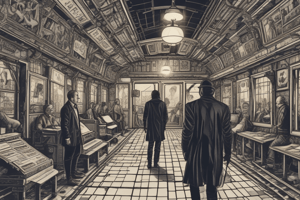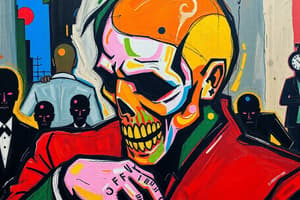Podcast
Questions and Answers
Biological theories of crime focus on social contexts of criminal behavior.
Biological theories of crime focus on social contexts of criminal behavior.
False (B)
Secondary victimization refers to the direct harm experienced by individuals who are crime victims.
Secondary victimization refers to the direct harm experienced by individuals who are crime victims.
False (B)
Victim characteristics such as socioeconomic status can influence their vulnerability to victimization.
Victim characteristics such as socioeconomic status can influence their vulnerability to victimization.
True (A)
Strain Theory posits that crime is influenced by social structures exerting pressure on individuals.
Strain Theory posits that crime is influenced by social structures exerting pressure on individuals.
Labeling Theory suggests that criminal behavior is learned through interactions with others.
Labeling Theory suggests that criminal behavior is learned through interactions with others.
The judiciary is responsible for crime prevention and apprehension of offenders.
The judiciary is responsible for crime prevention and apprehension of offenders.
Rehabilitation is a goal of the criminal justice system aimed at reforming offenders.
Rehabilitation is a goal of the criminal justice system aimed at reforming offenders.
Criminal justice processes do not include investigation or trial.
Criminal justice processes do not include investigation or trial.
Feminist Theory in criminal justice examines gender-based violence and inequality.
Feminist Theory in criminal justice examines gender-based violence and inequality.
Primary victimization refers to the trauma caused by the criminal justice system's response.
Primary victimization refers to the trauma caused by the criminal justice system's response.
Flashcards are hidden until you start studying
Study Notes
Theories of Crime
-
Biological Theories
- Focus on genetic, neurological, and physiological factors that influence criminal behavior.
- Examples include the twin studies and the effects of neurochemistry.
-
Psychological Theories
- Examine individual mental processes and personality traits related to crime.
- Includes concepts of aggression, mental disorders, and moral development.
-
Sociological Theories
- Highlight the social contexts of crime.
- Key theories:
- Strain Theory: Crime as a result of social structures that exert pressure on individuals.
- Social Learning Theory: Criminal behavior is learned through interactions with others.
- Labeling Theory: Stigmatization and labeling of individuals can lead to a self-fulfilling prophecy of crime.
-
Critical Theories
- Critique the societal structures that produce crime.
- Includes Marxist Theory (focus on capitalistic inequality) and Feminist Theory (examining gender-based violence and inequality).
Victimology
-
Definition
- Study of victims of crime, their behaviors, and experiences.
-
Types of Victimization
- Primary Victimization: Directly affected individuals.
- Secondary Victimization: Trauma or harm resulting from the criminal justice system's response.
-
Victim Characteristics
- Socioeconomic status, age, gender, and lifestyle can influence vulnerability to victimization.
-
Victim Rights
- Legal rights to participate in the criminal justice process.
- Initiatives to protect victims and provide support services (e.g., victim compensation programs).
Criminal Justice System
-
Components
- Law Enforcement: Police agencies responsible for crime prevention and apprehension of offenders.
- Judiciary: Courts that interpret laws, conduct trials, and determine guilt or innocence.
- Corrections: System of supervised confinement and rehabilitation for offenders, including prisons, parole, and probation.
-
Processes
- Investigation: Gathering evidence and building a case against suspects.
- Arrest: Taking individuals into custody based on probable cause.
- Trial: Legal proceedings to adjudicate guilt, involving prosecutors and defense attorneys.
- Sentencing: Judges impose penalties on convicted individuals.
-
Goals of the Criminal Justice System
- Deterrence: Discourage criminal behavior through punishment.
- Rehabilitation: Reform offenders to reintegrate them into society.
- Restorative Justice: Focus on healing for victims and communities, rather than solely punishment.
Theories of Crime
- Biological Theories focus on factors like genetics, brain structure, and hormones to explain criminal behavior.
- Twin Studies are used to explore the role of genetics in criminal behavior, comparing identical and fraternal twins.
- Psychological Theories examine individual mental processes, personality traits, and how they relate to crime.
- Sociological Theories emphasize the social context of criminal behavior.
- Strain Theory argues crime arises from social structures that create pressure on individuals, like lack of opportunities or social inequality.
- Social Learning Theory posits that individuals learn criminal behavior through interactions with others, observing and imitating.
- Labeling Theory suggests that societal labels and stigmatization can lead to self-fulfilling prophecies of criminal behavior.
- Critical Theories critique societal structures that contribute to crime.
- Marxist Theory focuses on how capitalistic inequality leads to crime.
- Feminist Theory examines gender-based violence and inequalities that contribute to criminal behavior.
Victimology
- Victimology studies victims of crime, their experiences, and how their actions influence victimization.
- Primary Victimization refers to the direct victim of a crime.
- Secondary Victimization refers to the trauma or harm experienced by victims due to the criminal justice system's response.
- Factors like socioeconomic status, age, gender, and lifestyle can increase vulnerability to victimization.
- Victims have legal rights to participate in the criminal justice process (e.g., being informed of court proceedings, testifying, victim compensation).
Criminal Justice System
- Law Enforcement agencies prevent crime, apprehend offenders, and investigate crimes.
- Judiciary comprises the courts which interpret laws, conduct trials, and determine guilt or innocence.
- Corrections focus on supervised confinement and rehabilitation for offenders, including prisons, parole, and probation.
- Investigation involves gathering evidence and building a case against suspects.
- Arrest is the taking of a suspect into custody based on probable cause.
- Trial is a legal process with prosecutors and defense attorneys arguing a case to determine guilt.
- Sentencing occurs after a guilty verdict where judges impose penalties on convicted individuals.
- The goals of the criminal justice system include:
- Deterrence: discouraging criminal behavior by the threat of punishment
- Rehabilitation: reforming offenders and reintegrating them into society
- Restorative Justice: healing and restoration for victims and communities affected by crime.
Studying That Suits You
Use AI to generate personalized quizzes and flashcards to suit your learning preferences.





